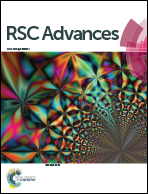Poly(3,4-ethylenedioxythiophene) (PEDOT) infused TiO2 nanofibers: the role of hole transport layer in photocatalytic degradation of phenazopyridine as a pharmaceutical contaminant
Abstract
Pharmaceuticals and personal care products are commonly discarded into environmental waters through sewers with human waste or by direct disposal causing serious contamination. Photocatalytic degradation of phenazopyridine (PAP) as a model pharmaceutical contaminant was investigated using TiO2 nanofibers and hybrid PEDOT infused TiO2 nanofibers. A novel material of PEDOT infused TiO2 nanofibers was fabricated via electrospinning and calcination to form TiO2 followed by the introduction of PEDOT using vapor phase polymerization. By changing the calcination temperature, the phase composition in TiO2 nanofibers can be adjusted to pure anatase phase, mixed phase and pure rutile phase. The photocatalytic activities of TiO2 nanofibers before and after PEDOT polymerization were measured by monitoring the decreasing concentration of PAP in aqueous solution under UV illumination using UV-Vis absorption spectroscopy. PEDOT infused TiO2 nanofibers showed an improved photocatalytic performance compared to their non-PEDOT infused counterparts for the degradation of PAP. This improvement can be attributed to the introduction of hole transport layer of PEDOT leading to an enhanced hole transfer from the TiO2 nanofibers to PEDOT. PEDOT infused rutile nanofiber has the most degradation enhancement (125%) compared to other two types of fibers (70% for PEDOT infused anatase & 30% for PEDOT infused mixed-phase).



 Please wait while we load your content...
Please wait while we load your content...